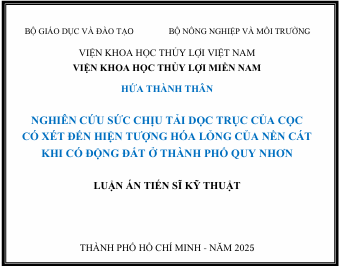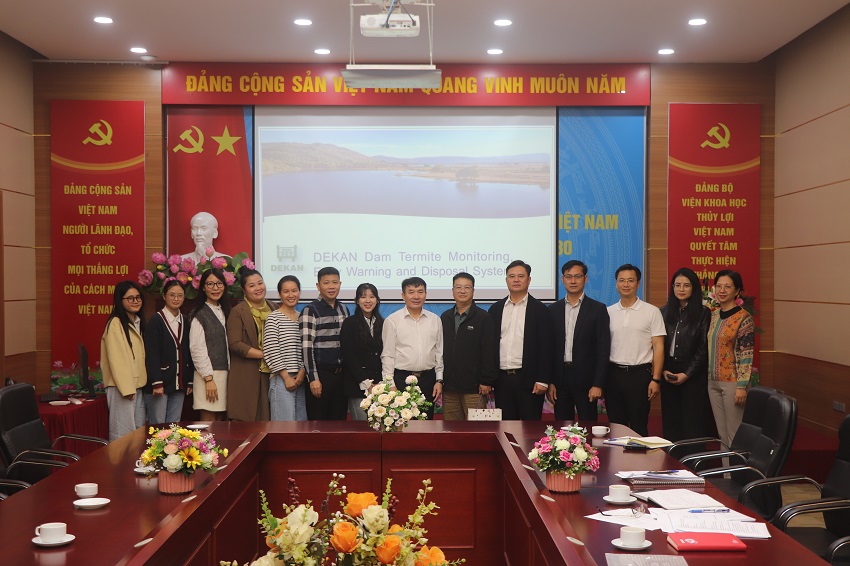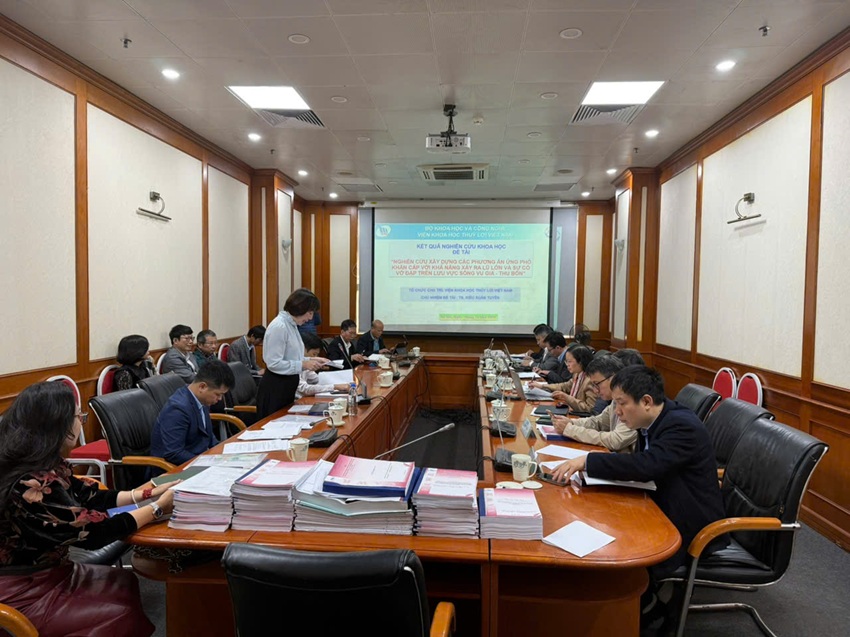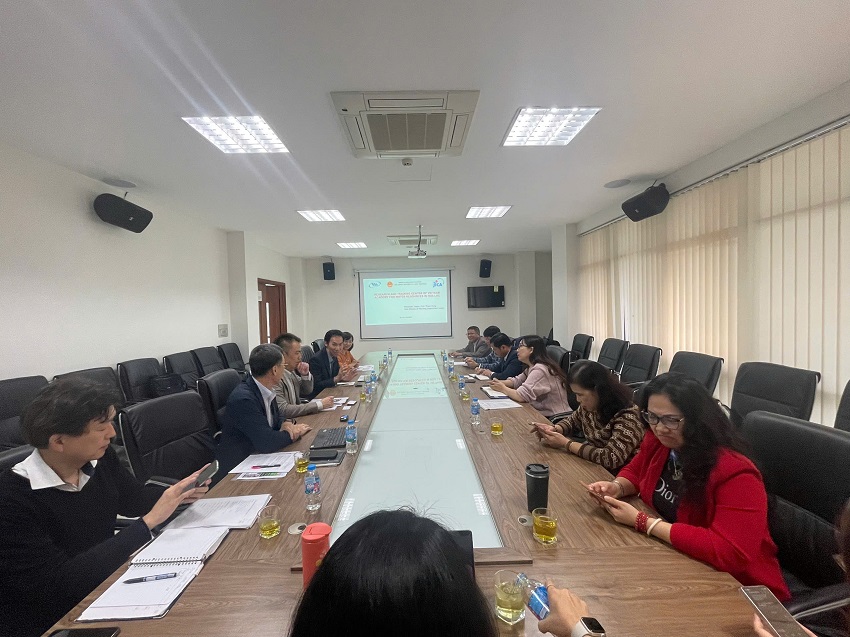Bản trích yếu luận án Tiến sỹ kỹ thuật của NCS. Đặng Ngọc Hạnh
15/04/2013Tên tác giả: Đặng Ngọc Hạnh. Tên luận án: "Nghiên cứu tính toán tiêu nước để đánh giá hiệu quả hệ thống bơm tiêu vùng đồng bằng sông Hồng (Áp dụng điển hình tại hệ thống Triều Dương)". Ngành học của Luận án: Tưới tiêu cho cây trồng. Mã số: 62 62 27 01. Tên cơ sở đào tạo: Viện Khoa học Thủy lợi Việt Nam
NỘI DUNG BẢN TRÍCH YẾU Mục đích và đối tượng nghiên cứu của luận án: - Đối tượng nghiên cứu: là bài toán tiêu nước phù hợp hệ thống bơm tiêu vùng đồng bằng sông Hồng, đánh giá hiệu quả tiêu nước cho đất nông nghiệp và giải pháp công trình đầu ô tiêu. - Mục đích nghiên cứu: Nghiên cứu đề xuất phương pháp tính toán tiêu nước và đánh giá hiệu quả tiêu đất nông nghiệp phù hợp với điều kiện thực tế hệ thống bơm tiêu vùng đồng bằng sông Hồng. Các phương pháp nghiên cứu đã sử dụng: - Thực nghiệm và quan trắc đồng ruộng. - Khảo sát thực địa kết hợp với khai thác bản đồ ảnh viễn thám và Internet. - Mô hình tính toán tiêu nước. - Phương pháp xử lý số liệu thực nghiệm và thử dần kiểm định kết quả tính toán. - Phương pháp tính toán chỉ số nội hoàn kinh tế (EIRR) và kế thừa. Các kết quả chính và kết luận: - Ý nghĩa thực tiễn: + Kết quả nghiên cứu làm cơ sở để tính toán hiệu quả kinh tế tiêu nước cho đất nông nghiệp và có thể lựa chọn hệ số tiêu thiết kế hợp lý. Kết quả cũng đóng góp cơ sở khoa học phục vụ cho công tác quy hoạch, thiết kế xây dựng, nâng cấp và hiện đại hóa công tác quản lý, lập kế hoạch, vận hành tiêu nước khoa học và có thể áp dụng xây dựng các bản đồ quản lý các đối tượng tiêu nước ở các hệ thống thủy nông. + Tỷ trọng tiêu nước cho đất nông nghiệp và phi nông nghiệp có thể làm cơ sở để xác định nguồn vốn đầu tư cho lĩnh vực nông nghiệp và phi nông nghiệp trong cơ cấu đầu tư hệ thống bơm tiêu. + Bổ sung công trình tràn vào đầu các ô tiêu có chân ruộng cao sẽ có hiệu quả đáng kể trong điều tiết giảm hệ số tiêu thiết kế tại đầu mối và nâng cao hiệu quả sử dụng nước mưa bên trong hệ thống. Cụ thể áp dụng ở vùng Triều Dương nếu đưa tràn vào đầu các ô tiêu có chân ruộng cao (chiếm gần 1/2 tổng diện tích lúa) là có hiệu quả rõ rệt, khi đó giảm được 1,0l/s-ha hệ số tiêu đầu mối và tăng 10% lượng nước mưa trữ lại để sử dụng bên trong hệ thống cho tưới và ngấm xuống nước ngầm. - Ý nghĩa khoa học: + Đã lựa chọn mô hình Duflow kết hợp với khảo sát phân tích chi tiết địa hình bằng bản đồ trực ảnh vệ tinh độ phân giải 0,56m để thiết lập mô hình tiêu nước trên cơ sở cải tiến thiết lập số liệu đầu vào kênh ô tiêu là phù hợp với hệ thống bơm tiêu vùng đồng bằng sông Hồng. + Xây dựng được phương pháp đánh giá hiệu quả tiêu cho đất nông nghiệp từ lợi ích nông nghiệp và tỷ trọng công suất bơm tiêu cho đất nông nghiệp và phi nông nghiệp, thực hiện thông qua mô hình tính toán tiêu nước phù hợp với hệ thống bơm tiêu vùng đồng bằng sông Hồng. + Mô hình tính toán tiêu nước trong luận án có khả năng tính toán và xây dựng quan hệ giữa hệ số tiêu hệ thống với diện tích úng ngập và chỉ số đánh giá hiệu quả kinh tế EIRR để kiến nghị lựa chọn hệ số tiêu thiết kế hợp lý và có hiệu quả kinh tế ở vùng đồng bằng sông Hồng là nên chấp nhận một tỷ lệ diện tích canh tác lúa nào đó không đảm bảo mức ngập cho phép (có nghĩa là phần diện tích này nếu có mưa thiết kế xảy ra mức thiệt hại năng suất sẽ vượt quá 10% nhưng nguy cơ này gần như không xảy ra) trong quá trình tính toán hệ số tiêu thiết kế. - Kết quả của luận án: Từ tổng quan đặc điểm hệ thống bơm tiêu vùng đồng bằng sông Hồng cho thấy hệ thống tiêu nước là sự kết nối của các ô tiêu với hệ thống kênh dẫn đến đầu mối tiêu nước. Việc nghiên cứu bài toán tiêu nước phù hợp với đặc điểm của các hệ thống bơm tiêu vẫn còn là vấn đề cần thiết. Từ trước tới nay, việc luận giải hiệu quả kinh tế hệ thống bơm tiêu chỉ bằng lợi ích từ chênh năng suất sản lượng "sau khi có dự án" so với "sau khi có dự án" từ các số liệu điều tra và thống kê trong khi nhiệm vụ tiêu nước phi nông nghiệp cũng rất lớn nhưng chưa có giải pháp nào để định lượng được tác ra khỏi quá trình tính toán hiệu quả kinh tế tiêu nông nghiệp, làm cho kết quả tính toán kinh tế là rất thấp, thiếu thực tế sẽ gây cản trở lớn đối với phát triển hệ thống bơm tiêu trong những năm tới. Hiện nay, hệ số tiêu thiết kế ở vùng ĐBSH là rất lớn và vẫn còn xu hướng tăng lên sau mỗi lần rà soát quy hoạch. Vậy hệ số tiêu thiết kế tới mức nào thì việc đầu tư xây dựng công trình bơm tiên vẫn có hiệu quả? và giải pháp công trình trên hệ thống như thế nào để nâng cao hiệu quả sử dụng nước mưa bên trong hệ thống mà vẫn đảm bảo tiêu nước? đó là những câu hỏi cần phải giải đáp để phục vụ quá trình phát triển và hiện đại hóa hệ thống bơm tiêu vùng ĐBSH. Do vậy, luận án đã đi sâu vào việc nghiên cứu các vấn đề nêu trên và đã đạt được một số kết quả sau: 1. Đề xuất được giải pháp tính toán tiêu nước của hệ thống thủy lợi bơm tiêu trên quan điểm phân tích hệ thống (từ mặt ruộng đến công trình đầu mối) phù hợp với hệ thống bơm tiêu vùng đồng bằng sông Hồng. 2. Đưa ra cách tiếp cận mới về nghiên cứu đánh giá hiệu quả tiêu, trước hết là đánh giá hiệu quả tiêu nước cho đất nông nghiệp. Theo đó, xác định tỷ trọng tiêu nước cho đất nông nghiệp và phi nông nghiệp làm cơ sở phân vốn đầu tư hợp lý cho hai đối tượng này. Đề xuất được phương pháp đánh giá hiệu quả tiêu đất nông nghiệp và xác định hệ số tiêu đảm bảo có hiệu quả về kinh tế. Kết quả áp dụng thành công tại vùng nghiên cứu điển hình ở hệ thống bơm tiêu Triều Dương cho kết quả tốt. 3. Bước đầu đã đưa ra cơ sở khoa học để đề xuất giải pháp công trình tràn điều tiết vào đầu những ô tiêu có chân ruộng cao trong hệ thống thủy nông sẽ giảm được khoảng 1,0 l/s-ha hệ số tiêu thiết kế tại đầu mối đồng thời tăng được khoảng 10% khối lượng nước trữ lại để sử dụng bên trong hệ thống. SYNOPSIS OF DISSERTATION a) Brief introduction Author of dissertation: Dang Ngoc Hanh Dissertation’s title: “Research and calculation of Drainage pumping systems for evaluation Effectiveness of Drainage in the Red river Delta (Case Study at Trieu Duong drainage pumping systems)” Field of study: Irrigation and Drainage; Code: 62 62 27 01 Institution: Vietnam Academy for Water Resources b) Synopsis of dissertation’s contents Objects and objectives of the research - Objects of the research: computer model suitable for drainage pumping systems in Red river delta, evaluation effectiveness of agriculture drainage and structure solution of on farm drainage canals. - Objectives of the research: Research and propose computer drainage model and evaluation effectiveness of drainage suitable for realistic condition of drainage pumping systems in Red river delta. Research methods utilized - Field experimental and observation method. - Field survey linkage with exploitation of remote sensing photograph from internet. - Model of drainage calculation method. - Method of analysis field data record and trial-and-error method. - Economic Internal Rate of Return (EIRR) and methods inherit. Research’s results and conclusions - Practical senses of the research + Research result is basic to economic evaluation of drainage for agriculture and also selection of sensible drainage coefficient. The result contributes scientific for mission relating to planning, design & construction, upgrading and modernizing on management, make plan operation and also development of management mapping on drainage objects in irrigation and drainage systems. + Ratio of drainage for agriculture and non-agriculture can be a basic to determine the sources of capital for agriculture sector and non-agriculture sector in investment structure of drainage pumping systems. + Add spillway at head of on farm drainage canal which have high field level will be significant effect on reducing of drainage coefficient and enhance significant effect of rain water used inside the systems. Specific, application at Trieu Duong area, if bring spillway to the on farm drainage canals which have high field level (make up nearly 1/2 of total rice field areas) will be significant effect, at that time reduces 1,0l/s-ha drainage coefficient and raises up 10% of rain water used inside the system for irrigation and percolation to ground water. - Scientific senses of the research + Propose Duflow model linkage with conducting detail topography survey at field and photo map with resolution 0,56m to establish drainage model base on basic of improvement input data establishment of on farm drainage canals which is suitable to pumping drainage systems in Red river delta. + Development of method to evaluate agricultural drainage effect from agricultural benefit and ratio of drainage for agriculture and non-agriculture which implementation by suitable pumping drainage model had been proposed above. + The suitable pumping drainage model can calculate and develop relationship between system drainage coefficient and inundation areas and EIRR indicator to recommend selection of sensible drainage coefficient with high economic effect which should accept a small ratio of rice field don't meet allowance logging degree (mean, this ratio will be loss more than 10% yield if designing rain fall happening but this danger is nearly not occurring) in process of design drainage coefficient calculation. - Research results The overview of drainage pumping system in the Red river delta have been found that, drainage system is linkage of on farm drainage canals with higher drainage canals to the pumping station. Research on problem of drainage which suitable to feature of drainage pumping systems is the issue needed. Ever, economic evaluation of drainage pumping system is difference of agricultural productivity between "with project" and "without project" by local statistic data and survey while non-agricultural benefit from drainage system is significant rate. In addition, there is not researching for assignment of mission between drainage for agriculture and non-agriculture in the drainage systems in process of economic evaluation of drainage pumping system, so the result of economic evaluation is often poor, not meet to the actual beneficiaries which will be constraint to develop of pumping drainage systems in Red rive delta in the near future. At the moment, design drainage coefficient in Red river delta is very extremely high and it is continuing higher after planning review. So, drainage coefficient will be go up to any level which ensure the construction of pump drainage system is still having economic effective? and any propose structure on the system to improve rain water used inside the system that still met the needed of drainage? they are big questions must be answer to support the process of development and modernization of drainage system in Red river delta. That why, the thesis have been to deep researching to the issues above and achieve the results summary as below: 1. Proposed a method of computer model of pumping drainage system base on the system analysis (from on farm to heard work of pumping station) which is suitable with practical condition of pumping drainage system in Red river delta. 2. Has brought out a new approach on researching and evaluation of effectiveness of drainage, firstly for drainage effect in agricultural sector. Following that, determination of drainage ratio for agricultural and non-agricultural sectors which is base to allocate suitable of invest capital for two drainage objects above. Proposed method to evaluate of drainage agricultural economic effective and find out the drainage coefficient which is insurance of economic effective. The results, has been applying successfully at case study in Trieu Duong drainage pumping system. 3. Initially has been brought out scientific base to propose of regulated spillway at the head of on farm drainage canals which have high level of rice field in the drainage system. This will be reduce of 1,0 l/s-ha drainage coefficient and simultaneously increase about 10% of rain water which is storage for used inside the drainage system.
Ý kiến góp ý:











